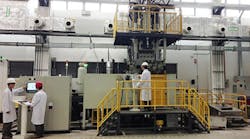General Motors Corporation’s GM China Advanced Technical Center (ATC) in Shanghai has started operating a new squeeze casting machine it developed. GM described the machine as “the first in the world” for “next-generation” magnesium castings.
Squeeze casting uses a pre-heated, two-part die that is filled with molten metal. Once the metal begins to solidify in one half of the die, the other half of the die is used to apply pressure while solidification proceeds. GM stated its new machine is a breakthrough in its lightweight materials research.
The Vertical Squeeze Casting (VSC) machine is installed at the 65,000-square meter research center that brings together several GM technical and design organization. GM stated its VSC machine was designed jointly by lightweight materials research teams in Detroit and Shanghai, and was built in collaboration with an unnamed Chinese equipment builder.
The production volume, product dimensions, and other capabilities of the machine were not described. GM stated only that squeeze casting technology would improve its products’ integrity by applying high squeeze pressure during the casting process.
Minimizing Inclusions in Magnesium
The design includes a fully enclosed, magnesium melting and transferring system that can improve casting quality and performance significantly, by isolating the molten metal from atmosphere, minimizing the potential for inclusions.
The automaker further claimed the new machine would make it easier to achieve volume production of magnesium automotive parts, which will help to improve fuel economy.
“The expected benefits of squeeze castings also mean we can use castings to replace some forged components at lower cost,” stated Jeff Wang, lab group manager of the materials research team at GM China Science Lab.
"Our efforts to promote magnesium alloy applications will not only meet customers' needs for better fuel economy and better performance at an affordable cost, but also take advantage of the ready availability of magnesium in China," said Wang.
China currently produces the majority of the world’s magnesium output.
Opened in 2011, the ATC, is GM’s center for advanced vehicle design, powertrain and vehicle engineering, “telematics,” and general R&D. The VSC machine is in located in the ATC’s micro-foundry and formability lab, which is part of the Advanced Materials Lab. The research center also has mechanical testing, microstructure analysis, metallography and electrochemistry labs.









